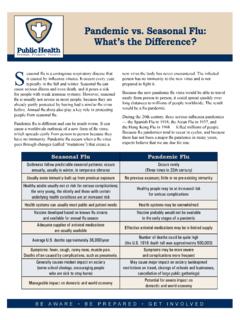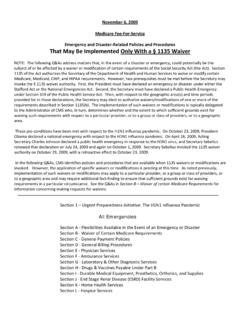Transcription of Bacteria Characterization of Big Creek and Buffalo …
1 Bacteria Characterization of Big Creek and Buffalo River near Carver Boone County Library September 23, 2014 Faron D. Usrey, Aquatic Ecologist Buffalo National River Buffalo National River Presentation Presuppositions (Acknowledging the Elephant in the Room) Environmental Science is the academic field that takes physical, biological, and chemical sciences to study the environment and discover solutions to environmental problems. (Science, Art, Social Sciences/~Politics) Confined Animal Feeding Operations (CAFO) most all meat, eggs, and milk products, goal is low cost food, wide variety of production types. 74% of world s poultry, 43% of beef, 68% of eggs (Worldwatch Institute 2006); Summary - CAFOs provides an important and necessary service to the human community.
2 National Parks special places set aside by citizens/their representatives, national public parks an unique American value, natural wonders and places of profound beauty, collectively preserved by citizens and entrusted to federal agencies, ultimate preservation value is generational, social fabric, and provides economic benefit to local and regional community. Water Resources sources of water that are useful or potentially useful (to humans). Uses include agriculture, industrial, household, recreational, and environmental activities. The majority of human uses require fresh water. (USGS) 1. Agriculture is essential. 2. Natural environment (water quality for human uses) is essential. 3. Education, understanding, and goodwill can reduce conflict and promotes positive decision making.
3 Therefore, we have means to reduce conflict between agricultural industry and water resources through a process of education an application of goodwill toward others. Buffalo National River Buffalo National River Created by Congress in 1972 by Public Law 92-237. Enabling legislation states: That for the purposes of conserving and interpreting an area containing unique scenic and scientific features, and preserving as a free-flowing stream an important segment of the Buffalo River in Arkansas for the benefit and enjoyment of present and future generations, the Secretary of Interior (hereinafter referred to as the Secretary ) may establish and administer the Buffalo National River. Mandate assumes that water quality would be monitored and maintained to a standard that is enjoyable during recreation and is safe for direct contact.
4 Purpose(s) of Park s Existence Buffalo National River Park s Recreation Use and Importance Recreation Patterns and Type Activities: canoeing, camping, caving, picnicking, hiking, swimming, sight-seeing, hunting, fishing, etc. (NPS data) Peak river use for water based recreation April through August 30% of river receives the majority of canoe traffic, upper and middle river Recreational river impacts: trash, boat launch area maintenance, gravel bar camping, etc. 2014 might be record high for river uses. Note: the majority of Bacteria enter river system from tributaries during non-base flow conditions, most water based recreation occur during base-flow conditions or post flood. Economic Benefit to Local Communities from National Park Visitation and Payroll, 2010 (Stynes, D.)
5 J., 2011. Michigan State University) Buffalo National River Recreation visits 1,545,599 Overnight stays 114,898 Visitor Spending All $47,169,000 and Non-local $41,554,000 Impacts of Non-Local Visitor Spending #Jobs 594 Buffalo National River History of Water Quality Program Monitoring plan was implemented in 1985 and continues today. 20 tributaries, 3 springs, and 9 river sites are monitored quarterly. BNR cooperatively works with Arkansas Department of Environmental Quality (ADEQ) and shares data with ADEQ (data available to public). ADEQ implements the Clean Water Act for Arkansas (Regulation #2). BNR does not have jurisdiction outside park boundaries accept for federally funded water projects that may diminish park s primary water resources.
6 Selected parameters monitored by BNR are based upon ADEQ Regulation #2 standards. Initial Goal for WQ program was environmental status and condition, is the river ecosystem health, near natural, etc. Added Escherichia coli (E. coli) in 2009 as requested by ADEQ Buffalo National River Ozark Natl. Forest27% Buffalo National River11%Private61%Ark. Game & Fish River Land Ownership840,000 acre watershedBuffalo National River Major Shift Water Quality Program Priorities Initial Priority Initial priority was basically to monitor, assess, and maintain good water quality, assess impacts of watershed development, protect the river from the impact of people. Roads and recreation within the park. Human activities and development within the watershed.
7 Defining what is natural from what is man-caused . Answering does water quality results conform to Reg.#2 standards? Additional Priorities and Shift toward Health and Human Safety for Visitor Use 2009 continuous sewage spill in Mill Creek (T04) Marble Falls Sewer District lift station failed post ice storm ~6,000 gallons/day into upper Mill Creek Dye trace indicated quick deliver of untreated human wastes to river First advisory and public warning issued in history of the park Shift priorities to protect people from poor water quality in the river. Dual Purpose of WQ Program Visitor Safety and Environmental Protection Added Escherichia coli to program. U of A Ph. D. Researcher Buffalo National River Arkansas Surface Water Bacteria Standards (Recreation) Regulation Bacteria Arkansas Department of Health has responsibility of approving or disapproving surface waters for the suitability of specifically delineated outdoor bathing places for body contact recreation.
8 Primary Contact Waters May 1 through September 30 Escherichia coli geometric mean (5 samples over 30 days): 126 colonies/100ml Single-sample maximum: 298 colonies/100ml Secondary Contact Waters October through April Escherichia coli geometric mean: 630 colonies/100ml Single-sample maximum: 1490 colonies/100ml Note: Since water based recreation occurs all year within the park, BNR assumes the maximum allowable risk for water based recreation to be set at Primary Contact Water levels; most safe and provides increase vigilance for visitor protection. Buffalo National River Assessment of Escherichia coli Concentrations in Surface Waters of Buffalo National River, 2009 through 2012 (Usrey, 2013) E. coli quarterly sampling at all monitoring sites Based on Reg.
9 # 2 Bacteria Criteria: single-sample maximum (298 cfu) Note: base-flow conditions only 1 river site out of 122 samples exceeded standard Nearly of tributaries exceeded standard One spring exceeded 2 out of 16 samples Conclusion: at base-flow, river sites are typically well below State standards for primary contact and are below acceptable health and human safety standards for recreational contact. 0510152025R01R02R03R04R05R06R07R08R09 Geometric mean E. coli (cfu/100ml) River Monitoring Sites E. coli Concentrations for Buffalo River Sites from 2009 through 2012 010203040506070T01T02T03T04T05T06T07T08T 09T10T11T12T13T14T15T16T17T18T23T24 Geometric Mean E. coli (cfu/100ml) Tributary Monitoring Sites E. coli Concentrations in Buffalo River Tributaries from 2009 through 2012 126 colonies/100ml Buffalo National River Background on Permitted Swine CAFO ADEQ issued a Confined Animal Feeding Operation (CAFO) in August of 2012 Permit for 2000 hog farrowing operation on Big Creek , Mt.
10 Judea Plan estimates up to 6503 hogs on site Annual waste stream estimated at 2,090,181 gallons of manure annually Applied on acres, some fields within floodplain of Big Creek Approximately 5 miles above BNR No mechanical treatment of manure (lagoons to field) Estimated seepage rate of lagoons maximum allowable 5,000 gallons per day Began operation in 2013 with first land application of manure in winter of 2013/2014 Information from permit application. Buffalo National River So Why is BNR Concerned about this CAFO? Visitor Health and Human Safety Arkansas Department of Health, March 2013 states we have concerns that water-borne pathogens-including E. coli and Cryptosporidium-from the proposed land application sites may pose a risk for body contact on the Buffalo National River, a popular recreational destination.





